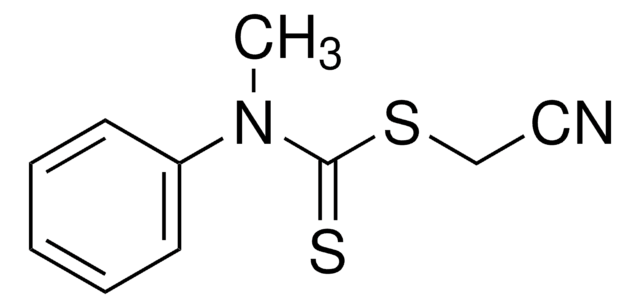723037
2-Cyano-2-propyl dodecyl trithiocarbonate
97% (HPLC)
Synonym(s):
S-(2-Cyanoprop-2-yl)-S-dodecyltrithiocarbonate
Sign Into View Organizational & Contract Pricing
All Photos(2)
About This Item
Empirical Formula (Hill Notation):
C17H31NS3
CAS Number:
Molecular Weight:
345.63
MDL number:
UNSPSC Code:
12352100
PubChem Substance ID:
NACRES:
NA.23
Recommended Products
Assay
97% (HPLC)
form
liquid
refractive index
n20/D 1.535
density
0.991 g/mL at 25 °C
storage temp.
2-8°C
SMILES string
CCCCCCCCCCCCSC(=S)SC(C)(C)C#N
InChI
1S/C17H31NS3/c1-4-5-6-7-8-9-10-11-12-13-14-20-16(19)21-17(2,3)15-18/h4-14H2,1-3H3
InChI key
QSVOWVXHKOQYIP-UHFFFAOYSA-N
Related Categories
General description
Need help choosing the correct RAFT Agent? Please consult the RAFT Agent to Monomer compatibility table.
Application
2-Cyano-2-propyl dodecyl trithiocarbonate is used as a RAFT agent for controlled radical polymerization; especially suited for the polymerization of methacrylate, methacrylamide, and styrene monomers. It is also used as a Chain Transfer Agent (CTA).
Choose from one of the most recent versions:
Already Own This Product?
Find documentation for the products that you have recently purchased in the Document Library.
Customers Also Viewed
Matías Regiart et al.
Analytica chimica acta, 963, 83-92 (2017-03-25)
We report a hybrid glass-poly (dimethylsiloxane) microfluidic immunosensor for epidermal growth factor receptor (EGFR) determination, based on the covalent immobilization of anti-EGFR antibody (anti-EGFR) on amino-functionalized mesoporous silica (AMS) retained in the central channel of a microfluidic device. The synthetized
So Jung Park et al.
ACS applied materials & interfaces, 12(43), 49165-49173 (2020-09-30)
Control of the cross-linking reaction is imperative when developing a sophisticated in situ forming hydrogel in the body. In this study, a heteroarmed thermoresponsive (TR) nanoparticle was designed to investigate the mechanism of controlling reactivity of the functional groups introduced
Jeonghun Lee et al.
Journal of controlled release : official journal of the Controlled Release Society, 304, 164-172 (2019-05-15)
A blood clot (thrombus) is formed as a final product of the hemostatic process with two major components, a mesh of cross-linked fibrin and platelets activated by high concentration of hydrogen peroxide (H2O2). Thrombus formation impedes blood flow to brain
Liqin Mei et al.
Journal of materials chemistry. B, 8(25), 5434-5440 (2020-06-13)
Zwitterionic polymers have attracted increasing attention due to their excellent fouling resistance ability and eco-friendliness. Yet, their non-degradability and hydrophilic nature limit their applications. In this study, we have prepared a novel surface-fragmenting hyperbranched copolymer with tertiary carboxybetaine ester (TCB)
Hsiu-Pen Lin et al.
Macromolecular bioscience, 20(6), e2000049-e2000049 (2020-04-08)
Cationic polymers exhibit high cytotoxicity via strong interaction with cell membranes. To reduce cell membrane damage, a hydrophilic polymer is introduced to the cationic nanoparticle surface. The hydrophilic polymer coating of cationic nanoparticles resulted in a nearly neutral nanoparticle. These
Our team of scientists has experience in all areas of research including Life Science, Material Science, Chemical Synthesis, Chromatography, Analytical and many others.
Contact Technical Service
![4-Cyano-4-[(dodecylsulfanylthiocarbonyl)sulfanyl]pentanoic acid 97% (HPLC)](/deepweb/assets/sigmaaldrich/product/structures/204/925/30ae6ca0-5b0b-4963-a061-7e5e3d1a85af/640/30ae6ca0-5b0b-4963-a061-7e5e3d1a85af.png)













![2-[[(2-Carboxyethyl)sulfanylthiocarbonyl]-sulfanyl]propanoic acid](/deepweb/assets/sigmaaldrich/product/structures/427/606/b02310e2-102e-4324-b09d-e4c0de4fab2c/640/b02310e2-102e-4324-b09d-e4c0de4fab2c.png)
